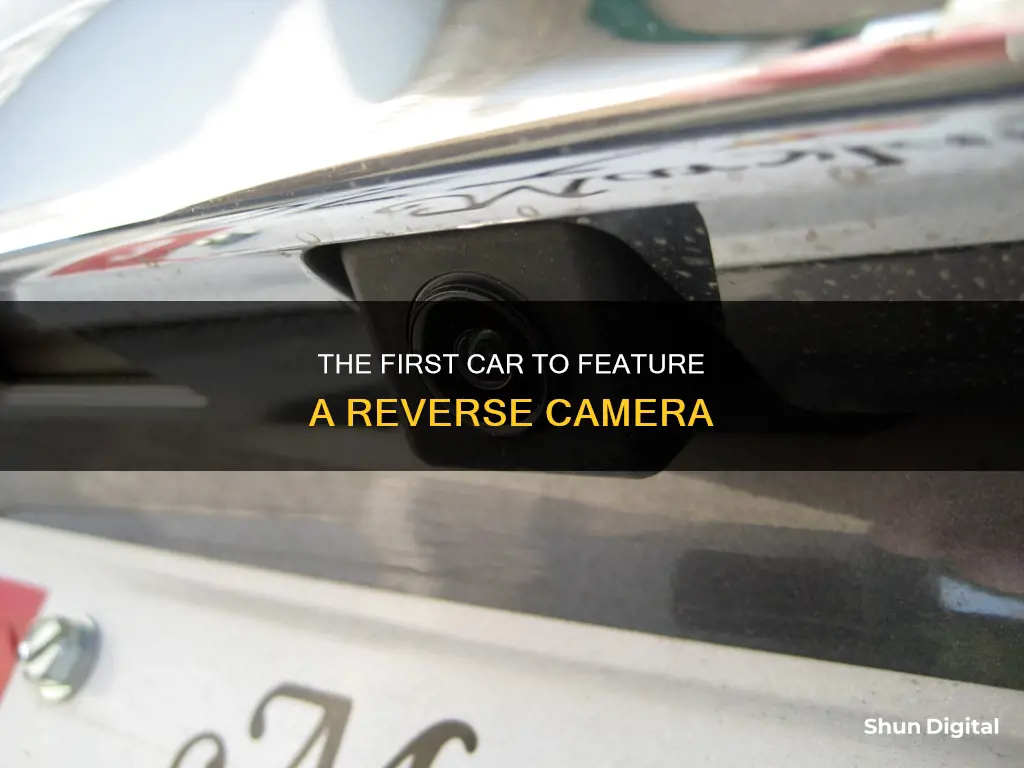
The first mass-produced car with a reverse camera was the 1991 Toyota Soarer Limited, which was only available in Japan. The Toyota Soarer's rear-view camera system featured a CCD (charged-coupled device) with a transistorized light sensor on an integrated circuit. This compact camera was fitted into the rear spoiler housing and transmitted a live colour feed to a dash-mounted screen, providing the driver with a clear view of objects below the rear-view mirror's line of sight. The system was discontinued in 1997.
| Characteristics | Values |
|---|---|
| Year | 1991 |
| Make | Toyota |
| Model | Soarer Limited |
| Market | Japanese |
| Camera Type | Charge-coupled device (CCD) with a transistorized light sensor on an integrated circuit |
| Display Type | Colour electro multi-vision (EMV) screen |
What You'll Learn
- The 1956 Buick Centurion was the first car with a reverse camera
- The 1991 Toyota Soarer was the first mass-produced car with a reverse camera
- The 2002 Infiniti Q45 was the first car in the US with a reverse camera
- Backup cameras became mandatory in the US and Canada in 2018
- Backup cameras improve safety and reduce collisions

The 1956 Buick Centurion was the first car with a reverse camera
The 1956 Buick Centurion was a concept car that debuted at the General Motors Motorama in January 1956. It was a sleek, futuristic vehicle with a jet-inspired design, a transparent bubble roof, and a fibreglass body. But what set it apart was its innovative use of a reverse camera system.
The Centurion was the first car to feature a rear-mounted television camera that transmitted images to a TV screen on the dashboard, eliminating the need for a rear-view mirror. This technology allowed drivers to see behind the car without physically turning around, providing a level of convenience and safety that was unprecedented at the time. The setup was bulkier than modern systems, with a large camera lens mounted at the rear and a screen on the dash. Despite being cutting-edge, the reverse camera concept didn't catch on immediately, even within Buick.
It's worth noting that the 1956 Buick Centurion was ahead of its time in more ways than one. Its design, influenced by the Jet Age, gave it a unique, futuristic appearance. The transparent bubble roof and cockpit offered unobstructed views, enhancing the driving experience. This concept car was a true pioneer, paving the way for future advancements in automotive safety and design.
While the 1956 Buick Centurion was the first car to introduce the concept of a reverse camera, it would be decades before this feature became standard in production vehicles. In 1991, the Toyota Soarer Limited became the first production car to incorporate a reverse camera system, initially available only in Japan. This was followed by the 2002 Infiniti Q45 sedan, which introduced the Rear-View Monitor system in the North American market.
The impact of the 1956 Buick Centurion's reverse camera technology cannot be overstated. It laid the foundation for a safety feature that would eventually become mandatory in new vehicles sold in the United States and Canada starting in 2018. This technology has proven to be a lifesaver, reducing accidents and fatalities caused by blind spots while reversing.
Smoke Detector Camera Batteries: How Long Do They Really Last?
You may want to see also

The 1991 Toyota Soarer was the first mass-produced car with a reverse camera
The Toyota Soarer was a coupe only available in Japan. Its reverse camera system was discontinued in 1997, but it paved the way for further advances in reverse camera technology. Today, reverse cameras are standard in all new cars sold in many countries, and have been credited with improving safety and reducing accidents.
In the United States, backup cameras became mandatory for all new cars sold from May 1, 2018. This was due to the safety benefits of reverse cameras, which help to reduce blind spots and improve visibility when reversing. Similar regulations were introduced in Canada in the same year, and European countries are also considering similar measures.
The inclusion of reverse cameras in cars has been a significant development in automotive technology, improving safety and reducing accidents. The 1991 Toyota Soarer was the first mass-produced car to include this feature, making it a pioneer in the automotive industry.
Surveillance Cameras: DIY Home Security on a Budget
You may want to see also

The 2002 Infiniti Q45 was the first car in the US with a reverse camera
The Infiniti Q45's reverse camera system was a significant development in automotive safety. Prior to this, the only cars with reverse cameras were concept vehicles or those produced for the Japanese market, such as the 1991 Toyota Soarer Limited. The Q45's introduction of this technology to the US market marked a shift towards improving visibility and reducing accidents while reversing.
The Infiniti Q45's reverse camera was just one of many safety innovations introduced by the automaker. In 2007, Infiniti debuted its Around View Monitor on the Infiniti EX35, offering drivers a 360-degree view around their vehicle. This system utilised four cameras positioned at the front, back, and sides of the car, creating a synthetic but accurate top-down view.
The inclusion of reverse cameras in cars has been a notable step towards enhancing safety and reducing blind spots. The National Highway Traffic Safety Administration (NHTSA) estimates that over 200 people are killed each year in accidents where the driver is backing up and unable to see behind the vehicle. The addition of reverse cameras has been proven to reduce such incidents, with the NHTSA reporting a steady decline in deaths, particularly among children.
The 2002 Infiniti Q45 played a pivotal role in bringing reverse camera technology to the US market. By offering drivers an enhanced view of their surroundings, this car contributed to a significant improvement in automotive safety and helped pave the way for further advancements in driver assistance systems.
Best Places to Sell Surveillance Cameras
You may want to see also

Backup cameras became mandatory in the US and Canada in 2018
In 2014, the United States' National Highway Traffic Safety Administration (NHTSA) announced that all automobiles sold in the country must include backup cameras from May 2018 onwards. This mandate was issued to reduce back-up collisions and back-over accidents, which cause an estimated 210 fatalities and 15,000 injuries in the US annually. The NHTSA had already been pushing for this regulation since 2007, but the USDOT repeatedly extended the deadline to analyse the costs and benefits of the requirement.
The backup camera mandate is part of a larger industry-wide trend toward the increased incorporation of electronics to improve driver, passenger, and pedestrian safety. These features, collectively known as advanced driver-assistance systems (ADAS), include blind-spot alerts, front and rear object detection, collision warnings, lane-keep assist, forward-collision alerts, brake assist, and automatic parking.
In Canada, Transport Canada issued a similar mandate in October 2016, requiring all new cars and small trucks sold in the country to be fitted with backup cameras from May 2018. This law was enacted in response to alarming statistics, with 27 deaths and 1,500 injuries occurring between 2004 and 2009 during backup manoeuvres, often involving young children who weren't visible through standard rear-view mirrors.
The backup camera mandate in both countries applies to all new vehicles sold, with certain specifications for the camera's field of view and display requirements.
How Diopter Adjustment Affects Camera Autofocus Performance
You may want to see also

Backup cameras improve safety and reduce collisions
Backup cameras, also known as reversing or rear-view cameras, are designed to aid in reversing and reducing the rear blind spot. This blind spot has been described as a "killing zone" due to the accidents it contributes to.
The first backup camera was used in the 1956 Buick Centurion concept car, presented in January 1956 at the General Motors Motorama. However, it was not until 1991 that the first production automobile, the Toyota Soarer Limited, incorporated a backup camera. In 2002, the Infiniti Q45 became the first vehicle with backup tech available in the US.
Since May 2018, backup cameras have been mandatory on all new vehicles sold in the United States. This regulation was established by the National Highway Traffic Safety Administration (NHTSA), which considers rearview video systems to be lifesaving technology, similar to airbags and seatbelts. Backup cameras are also regulated by law in Canada.
Backup cameras improve safety by providing drivers with a broader field of vision, eliminating blind spots, and offering on-screen guidelines and audible warning alerts. According to the NHTSA, more than 200 people are killed annually in accidents that occur while the driver is backing up and cannot see behind the vehicle. A study by the Insurance Institute for Highway Safety (IIHS) found that combining a camera with rear parking sensors reduced the backup collision rate by 42%, and adding automatic rear braking lowered the collision rate by 78%.
While backup cameras have improved safety and reduced collisions, it is important to note that they are not a replacement for mirrors or physically turning to look behind. They should be used in conjunction with other safety measures, such as checking blind spots and properly adjusting mirrors. Additionally, backup cameras have limitations, such as a narrow field of view, and can give drivers a false sense of security, leading to over-reliance on the technology. Federal data shows that even with the increase in backup cameras, injuries from backing accidents decreased by less than 8% from 2008 to 2011.
ReconYX Cameras: Where Are They Manufactured?
You may want to see also
Frequently asked questions
The first car to feature a reverse camera was the 1956 Buick Centurion concept car.
The first mass-produced car with a reverse camera was the 1991 Toyota Soarer Limited, also known as the UZZ31 and UZZ32.
No, the Toyota Soarer Limited was only available in Japan. The first car with a reverse camera available in the US was the 2002 Infiniti Q45 sedan.
The Toyota Soarer Limited featured a compact CCD camera with a transistorized light sensor on an integrated circuit. This was fitted into the car's rear spoiler housing and transmitted a live colour feed to a screen on the dashboard.
Reverse cameras improve safety by reducing the rear blind spot, often called the "killing zone" due to the accidents it contributes to.







